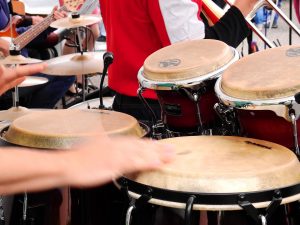History and Information
While most drum instruction takes place on the drum kit or drum set, there are also many forms of percussion outside of the set, which are generally known as known as auxiliary percussion. This can include cymbals, bells, shakers, bongos, congas, triangle, or other objects adapted for musical use. Since percussion instruments have been around for so long, there is an expansive repertoire of music to learn, including classical, blues, pop, rock, jazz, and folk.
When to Start
Students can start percussion lessons as young as age 6, although depending on a student’s dexterity and fine motor skills, some are able to pick it up earlier. Most instructors will incorporate reading music into their lessons, so students should know at least some reading and counting fundamentals.
Getting Auxiliary Percussion
There are many brands, models, and types of auxiliary percussion available. Your instructor can help you choose which instruments to get. For very young students, it is recommended to rent instruments for two reasons: 1) they will most likely grow out of instruments quickly and 2) they may lose interest (although we hope they don’t!). Most stores will provide repair services for instruments that they rent out. We can give you recommendations for places near you to buy or rent your percussion. Please contact us, and be sure to include your location!
Books and Supplies
Your instructor can tell you which books and supplies are appropriate. Most books and many supplies, including mallets, are available online. We can recommend stores near you where you can purchase supplies and music for your percussion, if you prefer to do so in person. Please contact us, and again, remember to tell us where you live!
**Feel free to contact us with any questions you may have. We can help provide you with additional resources.**

